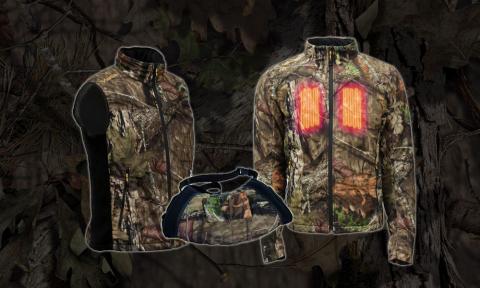Originally published in GameKeepers: Farming for Wildlife Magazine
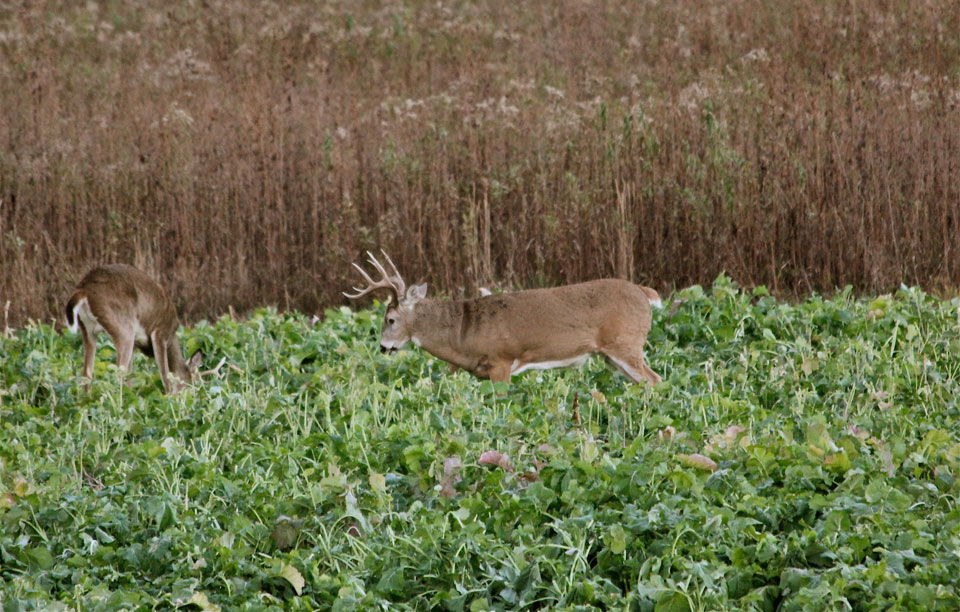
To some deer managers, weeds are like the “gift that keeps on giving…you a pain in the hind-end.” Weed seeds (and occasionally root systems or rhizomes) can sometimes sit dormant for several hundred years. Then we come along and change things so that it’s favorable for that nasty plant to take root. Why bother with weed control? Food plot weed killer and weed-beating methods prevent weeds from competing with your food plot crops and reducing the production, quality and utilization to a point until you have nothing left. Sure, a few weeds aren’t going to hurt and a totally weed-free plot can be difficult to realize, but to me, weeds are my adversary and I show no mercy. The summer weed cycle is relentless so you need to learn all the “tricks of the trade” if you wish to be master over it.
Target Identified: Attack Weeds Selectively
Many years ago I learned a trick from my long-time friends Craig and Neil Dougherty, famous father and son whitetail managers from New York. They had a slick way of getting rid of certain weed competition growing amongst their perennials by using glyphosate. How is that possible with a “complete burn-down, non-selective, contact herbicide” like glyphosate if you’re not using Roundup Ready crops? The key word here is “contact.” They had a technique so only the targeted plants would come in contact with the powerful non-selective herbicide.
A light herbicide-soaked blanket was wrapped around the bucket of the tractor. Then they would raise the bucket so it traveled above the desired crop, yet touched the nasty, taller, faster-growing weeds. This tactic worked especially well to remove certain weeds from perennial plots, but will work whenever you have weeds that are taller than your desired crop. Annual weeds like thistle, burdock, ragweed and others that pop up fast and grow taller can be touched by the chemical, while your clovers, alfalfa and chicory hide safely below the reach of the chemical-draped bucket.
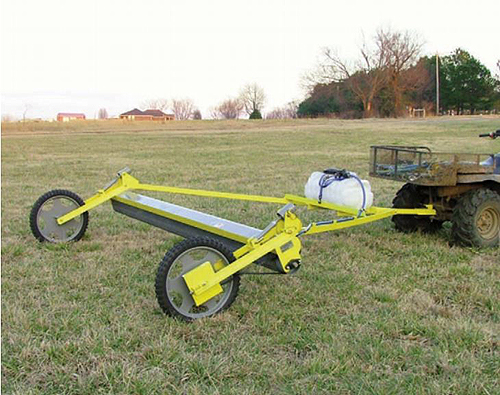
weeds by using glyphosate. It also works for applying other selective and
non-selective herbicides.
This system was spotty, difficult to refresh and you would kill a fair amount of desirable crops, but back then in was very inventive and we had nothing else. I don’t know why anyone would go to those extents anymore. Now, there are highly effective food plot weed killer and tools that do the same thing. For example, GrassWorks Weed Wiper™ makes this task easy. It’s really the ultimate tool for this technique. It eliminates any drip or drift concerns and allows you to apply chemical only to the weeds because of the role-on paint brush type application. The GrassWorks Weed Wiper allows you to use much less herbicide per acre because you target only the weeds and you eliminate the worry of drift problems because it can be used during windy conditions.
The Weed Wiper is different from any other system I have ever used because of the contact applicator and the rotating steel drum. As it is driven it turns in the opposite direction it is traveling so you make great contact with plants you are trying to get rid of. This rotating action does several pretty ingenious things. First, it allows you to run the herbicide on the rollers very saturated. Because it’s rotating it eliminates any drip. Second, because of the reverse-revolving rollers it’s applying the chemical to the underside of the leaves and stems. Some experts feel this is the weakest part of the plant and there is greater porosity so the chemical is absorbed quicker.
Obviously, with the adjustable height, your chemicals target only the weeds so we’re not wasting it on the crop that we want to keep. You can adjust the height range from zero inches on up to five feet high. This significantly saves you herbicide which in turn saves you time and money.
Lay Some Landmines
Certain plants have the ability to suppress competition around them, which can naturally help you achieve your weed control goals. Some plants do it by “direct competition,” they grow fast and shade out most opposition. Others change the soil microbial communities to make it difficult for certain plants to grow. Others use “allelopathy.”
“Allelopathy” refers to the effects of one plant on another plant. Various crops and weed species can release biochemicals, known as allelochemicals, by discharging from various plant parts and leaching through the soil, root exudation, volatilization, plant residue decomposition, and several other processes. The term “allelopathy” is from the Greek “allele” and “pathy,” meaning "mutual harm." Allelopathy can affect many aspects of plant biology, including specific plant rates, individual plant growth and plant succession, productivity and the creation of fruit. And for our purpose: dominance and the structure of plant communities. To sum up in layman’s terms, certain plants make it so others cannot grow near them.
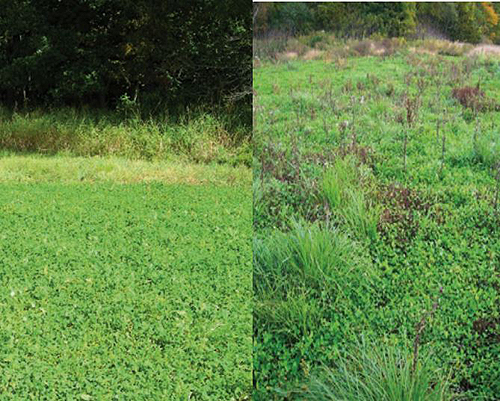
maintenance procedures. In the photo on the right, you have a nice stand
of perennials hidden under some nasty grass and weeds. In the photo on
the left, you see the same plot saved after applying selective herbicide,
mowing several times and fertilizing.
Wouldn’t it be great if a food plot crop had these characteristics? It just so happens that some do. Oats, wheat and some other cereals can form a dense root system that is difficult for weeds to penetrate. Buckwheat, millet, soybeans, cowpeas and many brassicas grow rapidly and will shadeout most competition. In addition to the direct competition approach, some brassicas produce glycosinolate compounds which will suppress weed competition. There are a few brassicas that will suppress competition, but few of these brassicas are attractive to whitetails. The Daikon radishes found in BioLogic’s new Deer Radish are one of the most attractive whitetail plantings we have ever seen, in addition to having this desirable characteristic to overpower any competition.
The plants in BioLogic Deer Radish produce “glycosinolate compounds,” which will suppress weed growth. They are an excellent choice for claiming new ground without having to use excessive glyphosate-based products. If that weren’t enough, under favorable growing conditions BioLogic Deer Radish can produce roots that will extend more than 3 feet deep in only 50 to 60 days, with the thick portion of the root (often referred to as a root-bulb or tuber) reaching up to 18 inches long and as big around as your forearm. This root growth busts-up the nastiest hard-pans. They also leave nutrients behind for future crops. Besides all of these great growth traits, in over 30 years of planting food plots and testing these plants for the past four years, I have never seen whitetails devour anything like they do this crop.
Switching Things Up
If you have an active native seed-bank that seems to be winning the “weed war,” or if you’re claiming new ground, you may want to change the order of steps that you do in plot preparation. Usually a person will kill the existing vegetation with glyphosate or some other non-selective, complete burn down herbicide, and then wait two weeks for the weeds to turn brown when they will then disk or till the area to prepare the seedbed. After that, they’ll plant and fertilize. Most fail to understand there will almost certainly be weed seeds lying dormant in the ground. When we come along and work the soil, by disturbing the soil we in essence “plant” those weed seeds. The seeds have been waiting for the correct set of conditions and can remain dormant in some cases for hundreds of years. Then we give them some fertilizer … the weeds love it! For several reasons, I believe changing the order and the timing of the steps will dramatically help prevent unwanted competition.
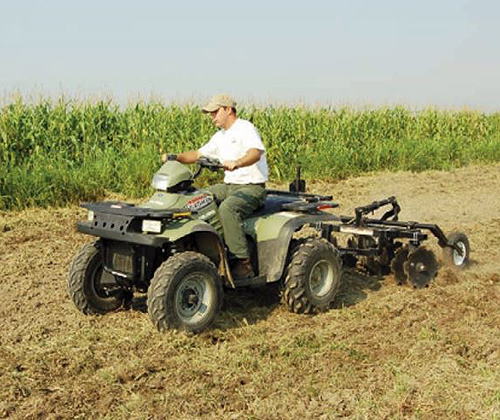
sprayed foliage to turn brown, then turns it under by disking or tilling, and
then plants and fertilizes. Oftentimes there will be weed seeds lying
dormant in the soil and by disturbing the soil we “plant” the weed seeds
. By simply changing around the order of planting steps you can
dramatically cut down on weed competition.
To begin, I would work your soil and prepare the seedbed well in advance of planting (3 to 6 weeks). For two reasons I would not kill the existing plants first unless they are tall or thick and difficult to turn under. The green plant residue will break down much faster than dried, brown, burned-down plant matter thus helping to retain any banked nutrients and moisture. The dry plant matter would rob your topsoil of moisture and the extra nitrogen it takes to turn the dried plant residue into valuable organic matter. Preparing the seedbed in advance also allows the valuable microorganisms and nematodes that do the work of breaking down plant mater a chance to repopulate after most were killed when you first worked the soil.
After working the soil, let the native seed-bank germinate and green-up…NOW kill everything with Roundup or your favorite non-selective, complete burn-down, contact herbicide. Then plant without working the soil again. This way you’ll prevent the accidental “planting” of more weed seeds from your native bank. The main point is to plant after herbicide burn-down, but without working the soil again.
Don’t Pick up Hitchhikers
It’s common sense, but I have to admit to doing it myself. As an example: you have some problem weeds (we’ll say thistles) on your property and it’s the perfect opportunity to mow them because you’re driving by and the bush-hog is attached to your tractor. Then a few days later you head to your best perennial plot to mow it without cleaning off the mower first. The next spring you see thistles popping up in your perennials and wonder how they got there. Doh! It’s just common sense. Maybe there’s a bit of laziness too – scraping all that caked-on plant residue off of your mower deck is certainly not a fun job, but it’s a necessary job if you want to prevent unwanted competition. This same philosophy goes for all your implements – disks, tillers, harrows, etc. Certain plants spread best by seed, others by rhizomes, and you don’t need a lot of either to make a huge patch of weeds or unwanted grass in your food plot. Keep your implements clean!
Show no Mercy
If you can’t identify the weed, take a sample to your Agriculture Extension office, a farm supply store with an agronomist on duty, a university agronomy department, or even a local farmer. There are some common selective herbicides that are safe to use over many popular food plot blends, but you must know what you’re dealing with before you begin spraying chemicals.
There are many selective herbicides used in the agricultural business, but the two types that are the most common when planting food plots would be a selective grass herbicide (only kills grass) like Select, Volunteer or Poast, or a broadleaf herbicide like 2,4-D, Pursuit or Raptor.
If you have a bad problem with one or the other type of (grass or broadleaf) competition I will sometimes suggest that you forgo a growing season and target that precise type of competition relentlessly. It doesn’t mean you can’t have a crop, it just means you have to be selective in what you plant. If you’ve had grass problems, like crabgrass or johnsongrass, then plant a broadleaf like clovers, brassicas or peas – then spray them to kill the grass. On the other hand, if you have a broadleaf problem, plant a grass such as grain sorghum, or a cereal grain like oats or wheat. Then you will be able to control the unwanted plant with selective chemical herbicides. In other words, you can kill your unwanted grass or broadleaf weeds by spraying right over the top without killing your desired food plot planting.
For more information on herbicide, please contact a BioLogic consultant.
Concerning perennials … just mow them! You’ll almost certainly need to spray a selective grass herbicide over your perennials, but if you have broadleaf weed problems in your perennials and your pH is neutral, and you fertilize properly (no nitrogen and according to soil test results) then you likely haven’t mowed … at least not often enough. I don’t know why some people are leery of mowing their perennials – it’s good for them! Perennials like to be mowed; Most broadleaf weeds do not. Besides reducing broadleaf weed competition, mowing will produce more palatable growth on your perennials and stimulate stolon production which will lead to thicker, healthier stands. It depends on many details as to how often and how aggressive you should mow, but almost certainly you should be mowing at least three times during the growing season at a minimum.
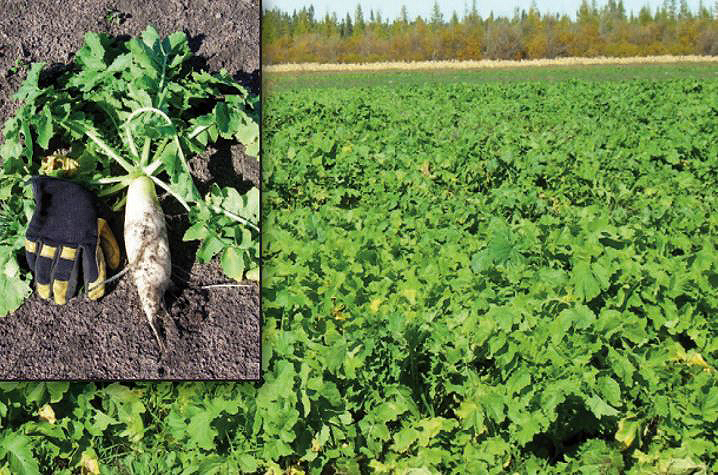
by releasing biochemicals, known as allelochemicals, to make it difficult for certain plants to grow.
BioLogic’s Deer Radish produces glycosinolate compounds which suppress the growth of competing
plants.
That’s Corny
It may seem cliché, but the best defense against weed competition is creating an environment best suited for your specific crop. You want to manipulate the soil to have the correct pH, the right nutrient load, acceptable moisture and sunlight levels, and the proper amount of organic matter for your chosen food plot crop, not the native plants or any other wild weed. Many plants (both crops and natives) will do well in a wide range of conditions, so since there will certainly be some sort of competition, you need to give your specific crop the best chance for success. Set yourself up for victory. I’ve watched hundreds of customers gab a bag of seed and think they’re going to “whip it out and grow themselves a food plot,” then reap the rewards from then “until the cows come home.” Most will contact us shortly after their disappointment and want to learn how to do it right. More concerning is some will do the same thing, the same way for several years before they admit defeat and learn to do it correctly …maybe it’s testosterone or maybe it’s just plain stupidity.
Many of us learn the hard way, by experiencing several failures, that testing the soil is vital to our consistent success. In this endeavor a failure can mean losing hundreds, if not thousands of dollars. Almost more “costly” is the fact that you have to wait an entire year to try again. Sure, Mother Nature can throw you a curve ball and there may be nothing you can do, but getting your soil right and following proper planting and maintenance procedures are essential to ongoing success.
Especially when claiming new ground, you must change the soil to benefit your selected crop. The environment that was present before you came along to claim that spot was perfectly suited for the specific native plants that were growing there; you need to manipulate the soil so that the conditions are now perfect for your chosen crop. A vigorous environment that has the distinctive characteristics best for your specific crop is what you want. A strong food plot with healthy soil is the absolute best defense against unwanted competition.















